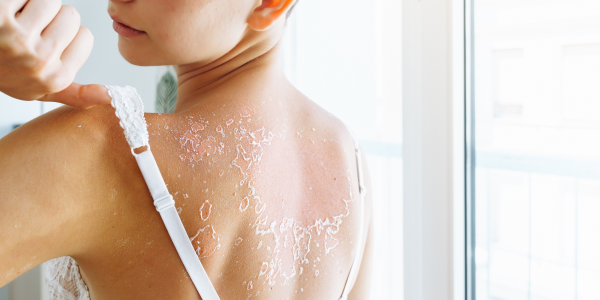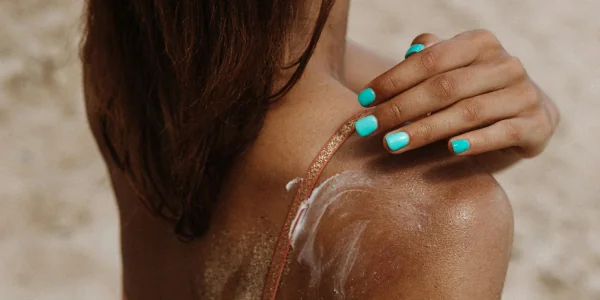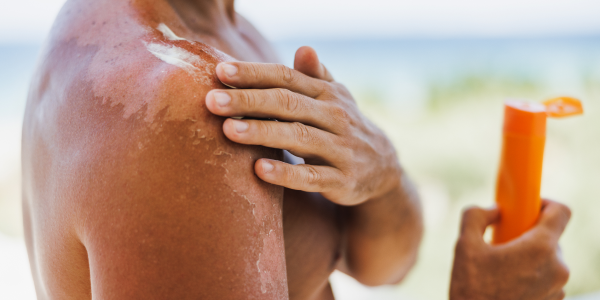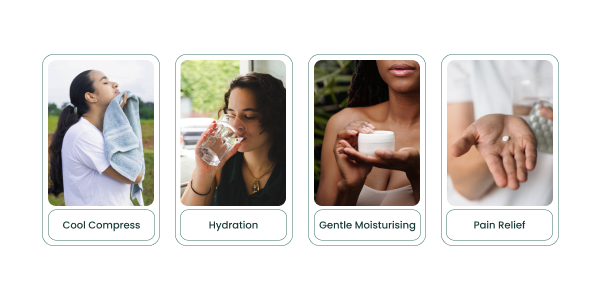
Sunburn might seem like a temporary inconvenience, but it’s your skin’s distress signal after suffering cellular damage. Understanding what happens beneath the surface can help you protect yourself and respond appropriately when prevention falls short.
What Happens to Your Skin During Sunburn: The Science of Sun Damage
hen ultraviolet (UV) radiation from the sun hits your skin, it penetrates the outer layer and damages the DNA within skin cells. This triggers an inflammatory response as your immune system rushes to repair the damage. The characteristic redness and heat of sunburn is increased blood flow to the affected area, bringing immune cells and nutrients to begin the healing process.
UV radiation comes in two main types that affect your skin differently. UVA rays penetrate deeper into the skin, contributing to premature ageing and increasing skin cancer risk. UVB rays primarily affect the outer skin layer and are the main cause of sunburn. Both types damage the DNA in skin cells, but your skin attempts to protect itself by producing more melanin (the pigment that gives skin its colour) and by thickening the outer layer.

The inflammatory response causes the familiar symptoms of sunburn: redness, heat, swelling, and pain. In severe cases, the damage is so extensive that the skin forms blisters as it attempts to protect the deeper layers. This entire process typically peaks 24-48 hours after exposure, which is why sunburn often feels worse the day after sun exposure.
Sunburn Risks: From Short-Term Pain to Long-Term Skin Cancer
The immediate discomfort of sunburn is just the beginning of the story. While the redness and pain usually subside within a few days to a week, the underlying damage can have lasting consequences. Each episode of sunburn increases your risk of developing skin cancer later in life, as the UV damage accumulates over time.
In the UK, almost 9 in 10 cases of melanoma skin cancer could be prevented by staying safe in the sun and avoiding sunbeds. The number of new melanoma skin cancer cases on average each year in the UK is projected to rise from around 20,800 cases in 2023-2025 to around 26,500 cases in 2038-2040.
Beyond cancer risk, repeated sun damage leads to premature skin ageing, including:
- Deep wrinkles and fine lines
- Age spots and uneven pigmentation
- Leathery skin texture
- Loss of skin elasticity
- Broken blood vessels
People who experienced severe sunburns during childhood face particularly elevated risks, as young skin is more vulnerable to UV damage. However, skin damage is cumulative, meaning every sunburn throughout your life adds to your overall risk profile.
How to Prevent Sunburn: Best Practices and Dangerous Myths
Effective sun protection requires a multi-layered approach. In the UK, the risk of getting sunburnt is highest from March to October, particularly from 11am to 3pm, when the sun’s rays are strongest.

Essential prevention strategies include:
- Sunscreen application: Use broad-spectrum sunscreen with at least SPF 30 and suitable UVA protection of at least 4-stars, applied generously 15-30 minutes before sun exposure. Reapply every two hours and immediately after swimming or sweating.
- Seek shade: Particularly during peak UV hours (11am-3pm in the UK). Remember that UV rays can reflect off water, sand, and concrete, increasing exposure even in shaded areas.
- Protective clothing: Wear long-sleeved shirts, long trousers, and wide-brimmed hats when possible. Darker, tightly woven fabrics offer better protection.
- UV-blocking sunglasses: Protect the delicate skin around your eyes and reduce the risk of cataracts.
Common myths that can be dangerous:
- “Base tans protect you”: There’s no such thing as a safe tan. Any change in skin colour indicates DNA damage.
- “You can’t burn on cloudy days”: Up to 90% of UV rays can penetrate clouds.
- “Sunscreen prevents vitamin D production”: While sunscreen reduces vitamin D synthesis, most people can maintain adequate levels with brief, unprotected sun exposure or dietary sources.
- “Darker skin doesn’t need protection”: While melanin provides some natural protection, people of all skin tones can burn and develop skin cancer.

Sunburn Aftercare: Soothing and Healing Damaged Skin
If you do get sunburned, proper aftercare can reduce discomfort and support healing. Cool your skin with a cool shower, bath or damp towel (take care not to let a baby or young child get too cold).
Immediate steps for sunburn relief:
- Cool compresses: Apply cool, damp cloths to affected areas for 10-15 minutes several times daily.
- Hydration: Drink plenty of water to help your body heal and prevent dehydration.
- Gentle moisturising: Use fragrance-free moisturisers containing aloe vera while skin is still damp to lock in moisture.
- Pain relief: Over-the-counter pain relievers like ibuprofen or paracetamol can reduce inflammation and discomfort.

What to avoid:
- Petroleum-based products, which can trap heat
- Ice directly on the skin
- Popping blisters, which increases infection risk
- Further sun exposure until skin heals
Keep affected areas moisturised and avoid harsh soaps or exfoliants. Peeling is a natural part of the healing process but resist the urge to pick at loose skin.
Sources: NHS – Sunburn
When to Seek Medical Help for a Severe Sunburn
While most sunburns can be managed at home, some situations require professional medical attention. The NHS advises seeking urgent medical help if you’ve been out in the sun and experience certain warning signs.
Severe symptoms requiring urgent care:
- Extensive blistering covering a large area
- Signs of infection (increasing pain, swelling, pus, red streaking)
- Your temperature is very high, or you feel hot and shivery
- Severe chills or headache
- Signs of dehydration (dizziness, rapid heartbeat, decreased urination)
- Nausea or vomiting
- Signs of heat exhaustion or heatstroke
Remember, sunburn is entirely preventable with proper sun safety measures. By understanding the science behind sun damage and taking appropriate precautions, you can enjoy the outdoors while protecting your skin’s long-term health. The key is making sun protection a daily habit, not just something you think about on beach holidays.
Need treatment or advice? Get your NHS prescriptions delivered for free with e-Pharmacy.
This article is intended for informational purposes only and does not constitute medical advice. Please consult with a healthcare professional for personalised medical guidance.





